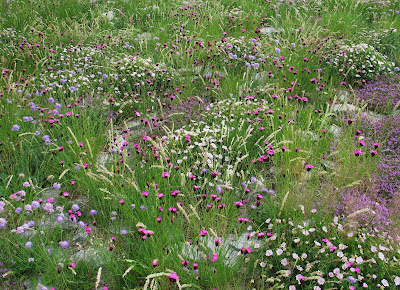Under the heading "Blütengarten der Zukunft" in the German magazine Garten Praxis the editor Jonas Reif has invited different garden personalities to share their views on the flourishing gardens of the future. The title is taken from Karl Foerster's famous book "Vom Blütengarten der Zukunft", ie future flower garden, which came out in 1917.
In the latest issue, released in February, I am contributing with an article translated into German. If you do not have access to Garten Praxis and prefer English I am here publishing the original text. Go ahead, enjoy!
A Poppy meadow - the opposite of a static planting
A good example of the strictly controlled, static garden is the classic perennial border.
Here the perennials are planted in blocks or patches and the idea is that they should remain in the spaces allotted to them, not to sneak off to their neighbors. The planting is then usually viewed from a mowed lawn.
Even if static plantings of course can be very beautiful, they always look unnatural and arranged. In nature, you rarely stand on a mowed lawn and look at the forest, the meadow or the beach. Instead you are an integral part of the habitat you visit. You're actively in the forest and can move freely among the trees and flowers and are not merely a passive observer.
And above all, here the plants are not growing in rows or squares, rigid blocks or distinct modules. On the meadow the perennials are developing without the gardener's constant restrictions. That kind of plantings I want to see more of in the future.
Although all plantings are arranged to some extent unless the plants have invaded the site on their own, the method of planting in well-defined blocks makes it also appears that it really is artificial. In the future I would like to see more ecological, dynamic gardens where succession is a desired concept, where the plants are allowed to self-seed and spread, where the leaves gnawed by insects is an aim in itself and where biodiversity is a priority.
It is possible to make a wide range of different biotopes in parks and gardens as groves and woodlands, swamps and bogs, wet meadows and dry meadows, prairies, heaths and steppes.
These days, when more and more gardens are covered with slabs and other stone materials, it would be a great opportunity to introduce the well-drained, long blooming, low maintenance stone and gravel garden to a broader public. I'm very surprised that this garden trend has not already occurred, because the extreme dry habitat garden is very exquisite and extremely easy to maintain.
You can use any type of sand and gravel in a dry habitat garden, but with lime stone fewer unwanted species will thrive. Anyone who have ever seen a well composed flowering steppe-like planting will want to have one in their own garden. But the steppe as theme isn't only suitable for a family garden but even more for public spaces where it is important with low maintenance costs.
Despite the influences from Karl Foerster, Richard Hansen, Rosemarie Weisse and some others, all kind of habitat plantings still are rare in Germany and elsewhere. Let us change that! Start digging and create your flowering steppe already today!
Vom Blütengarten der Zukunft. Das neue Zeitalter des Gartens und das Geheimnis der veredelten winterfesten Dauerpflanzen.









Beautiful Photos and Inspiring Article, Peter!
ReplyDeleteAlmost a hundred years ago, and we are still inspired by Karl Foerster.
ReplyDeleteInsect nibbled leaves as a proud aim in our gardens - yes, that would be my garden of the future.
i read your blog and found the nice description about SYNTHETIC TURF...
ReplyDeleteArtificial lawn perth
Wonderful and inspiring...if those photos don't convince people of the promise of such a practice...nothing will...they are gorgeous!
ReplyDeleteDid you realize there's a 12 word phrase you can tell your partner... that will trigger deep feelings of love and impulsive appeal for you deep within his chest?
ReplyDeleteThat's because deep inside these 12 words is a "secret signal" that triggers a man's instinct to love, adore and look after you with all his heart...
12 Words That Trigger A Man's Love Response
This instinct is so built-in to a man's brain that it will drive him to try better than ever before to make your relationship the best part of both of your lives.
In fact, fueling this influential instinct is so binding to getting the best ever relationship with your man that the moment you send your man one of the "Secret Signals"...
...You will immediately find him open his soul and heart for you in such a way he haven't expressed before and he'll recognize you as the one and only woman in the galaxy who has ever truly fascinated him.